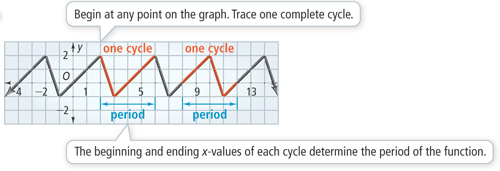13-1 Exploring Periodic Data
Objectives
To identify cycles and periods of periodic functions
To find the amplitude of periodic functions

 Lesson Vocabulary
Lesson Vocabulary
- periodic function
- cycle
- period
- amplitude
A periodic function is a function that repeats a pattern of y-values (outputs) at regular intervals. One complete pattern is a cycle. A cycle may begin at any point on the graph of the function. The period of a function is the horizontal length of one cycle.
Essential Understanding Periodic behavior is behavior that repeats over intervals of constant length.
 Problem 1 Identifying Cycles and Periods
Problem 1 Identifying Cycles and Periods
Analyze the periodic function below. Identify the cycle in two different ways. What is the period of the function?
Think
Is there a good point at which to start the cycle?
If you start at the maximum value, it is easy to tell when you have completed the cycle.
One cycle begins at
Table of Contents
- 5-1 Polynomial Functions
- 5-2 Polynomials, Linear Factors, and Zeros
- 5-3 Solving Polynomial Equations
- 5-4 Dividing Polynomials
- 5-5 Theorems About Roots of Polynomial Equations
- 5-6 The Fundamental Theorem of Algebra
- 5-7 The Binomial Theorem
- 5-8 Polynomial Models in the Real World
- 5-9 Transforming Polynomial Functions





